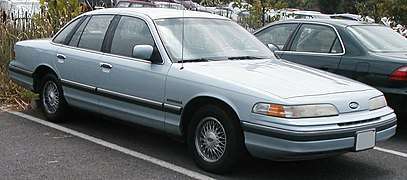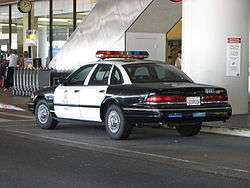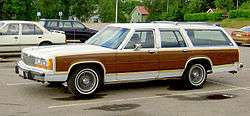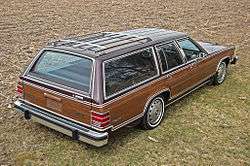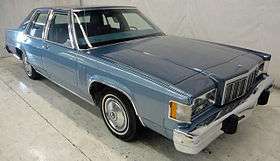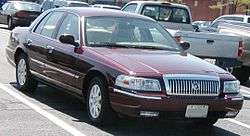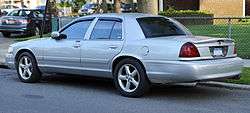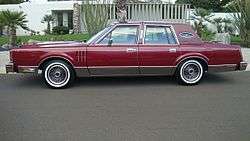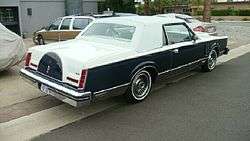Ford Panther platform
| Ford Panther platform | |
|---|---|
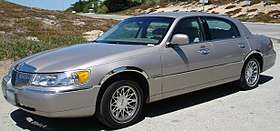 | |
| Overview | |
| Manufacturer |
Ford Motor Company Mercury Lincoln |
| Production | 1978–2011 |
| Assembly | |
| Body and chassis | |
| Class |
Full-size car Full-size luxury car Personal luxury car Limousine |
| Layout | FR layout, body-on-frame |
| Body style(s) |
2-door sedan (1979–1987) 4-door sedan (1979–2012) 5-door station wagon (1979–1991) |
| Vehicles |
Ford models
|
| Powertrain | |
| Engine(s) |
Ford 4.2L Windsor V8 (1981–1982) Ford 5.0L Windsor V8 (1979–1991) Ford 351/5.8L Windsor V8 (1979–1991) Ford 4.6L Modular V8 (1991–2012) |
| Chronology | |
| Predecessor |
1973–1978 Full-size Ford 1970–1979 Lincoln Continental |
| Successor | Ford D3 platform |
The Ford Panther platform is an automobile platform that was used by Ford Motor Company for full-size, rear-wheel drive sedans from 1978 to 2011. Introduced for the 1979 model year, it was progressively updated during its production run.
At the time of its 2011 discontinuation, the Panther platform was in use longer (32 model years) than any other platform in North American automotive history. It was initially developed as a response to the downsizing of full-size cars from Chrysler and General Motors due to increasingly stringent fuel economy standards for cars. During trying periods for Ford, the Panther cars were scheduled for cancellation and replacement (in favor of the front-wheel drive D186 platform) on several occasions, as early as 1985.
As the 1980s progressed, the full-size cars of the Buick, Oldsmobile, and Pontiac divisions were downsized further; all were replaced by front-wheel drive cars. The Panther's final GM counterparts, the Chevrolet Caprice, Buick Roadmaster and Cadillac Fleetwood were discontinued in 1996. By 1982, Chrysler left the full-size car class completely. In the early 1990s, Chrysler resumed production of FWD full-size cars (the LH platform) and rear-wheel drive (the LX platform) a decade later. However, with the majority of these cars, Chrysler competed against different customers that Ford attracted with the Panther platform.
The Panther platform was produced at Ford's St. Thomas Assembly plant in Talbotville, Ontario, Canada, with the last vehicle rolling off the line 15 September 2011. Prior to its closure on 31 May 2007, the Wixom Assembly Plant in Michigan was the assembly site for the Lincoln Town Car. Assembly of the Town Car was consolidated at the St. Thomas plant in January 2008 following paint shop and other upgrades. Ford and Mercury versions built before the 1986 model year were assembled in the St. Louis Assembly Plant in Missouri; this facility is currently closed. The closure of the St. Thomas plant is also the end of an era for mainstream full-size automobiles using the body-on-frame platform in North America, primarily in the United States and Canada where the rest of the world uses unibody construction.
Design overview
The Panther platform utilized the body-on-frame construction with live rear axle suspension. While commonplace during its late-1970s introduction, it is a design found almost exclusively in large SUVs and pickup trucks today. The durability resulting from the body on frame construction (which allows easier repair after minor collisions), and their relatively simple design make the Panther cars appealing as fleet vehicles, including police cars and taxicabs. The Lincoln Town Car appealed largely to livery services, and is the most commonly used limousine in North America, due to its ability to be easily "stretched" by lengthening the frame without compromising chassis strength.[1]
Although introduced in 1978, the Panther platform has undergone major changes along the way. Through its design life, it has been produced in three distinct generations:
- First generation (1979–1991): The initial versions; the only versions produced in bodystyles other than a four-door sedan. The only generation to use the Windsor V8 engine
- Second generation (1990–2002): Extensive redesigns of exterior and interior; introduction of Modular V8 engine
- Third generation (2003–2012): Frame and suspension redesigns and upgrades to improve handling. 2011 was the last model year for the North American Market and for Lincoln-Mercury models. A limited number of 2012 Crown Victorias were built for the police and overseas market.
First generation (1978–1991)
The first cars introduced on the Panther platform were the downsized 1979 Ford LTD and Mercury Marquis. Both were available in coupe, wagon, and sedan bodystyles. For 1980, federal fuel-economy regulations forced the Lincoln Continental to downsize; for the first time, the flagship cars for all three divisions shared a common platform. All Ford and Mercury models were now built on a common wheelbase; aside from grilles and taillights, the bodyshells were identical as well. In the Lincoln lineup, the Continental, Town Car, and Continental Mark VI shared nearly identical bodywork. In 1982, the Town Car became a model line of its own as the Continental became a mid-sized Fox-platform car; the Mark VI ended production in 1983. While Lincoln coupes (Mark VI and the rare Town Coupe) based on the Panther platform were discontinued in 1983, Ford and Mercury coupes lasted until 1987, when low demand brought their cancellation.
- Changes
Ford made relatively few changes to any of the 1st-generation Panther-platform cars throughout their production life aside from nameplate changes. A 1988 re-style of the LTD Crown Victoria, Country Squire, and Grand Marquis improved their aerodynamics.[2] 1990 marked the addition of SRS airbags to the Panther platform. The Lincoln Town Car came with dual air bags standard, but the passenger air bag remained an option on Ford and Mercury versions until 1993.
The 1st-generation Panther was also:
- The last American car with functional vent windows (option on 1989 Ford/Mercury)
- The last American-brand car available with a carbureted engine (351 cubic-inch V8; option on Grand Marquis, Crown Victoria wagon/police car through 1991)
Second generation (1990–2002)
The American automotive landscape had changed significantly throughout the 1980s, although Ford had left the Panther platform essentially unchanged. A combination of changing consumer tastes as well as increasingly more stringent fuel economy standards forced Ford to make significant changes to the Panther cars in order to keep them in production. Bucking industry trends of the time, Ford chose not to downsize it any further or to replace it entirely with a front-wheel drive platform, opting instead for more aerodynamic bodystyling (which had been popularized by the smaller Taurus) and an all-new powertrain. As a result of changing market trends towards minivans and sport utility vehicles, one casualty of the redesign was the Country Squire and Colony Park station wagons; at the time, their de facto replacement was the Ford Aerostar.
In October 1989, Lincoln introduced the second-generation Town Car. In early 1991, the Crown Victoria (the LTD prefix disappeared) and Grand Marquis received total redesigns of their bodies for 1992. The Ford was restyled to have more of a family resemblance to the Ford Taurus, while the Mercury was styled as a more contemporary version of its predecessor (a formal family sedan).
- 4.6-liter "Modular" V8
In 1991, the 4.6L SOHC Modular V8 debuted under the hood of the Lincoln Town Car. It was the replacement for both the 302 and 351 cubic-inch Windsor V8 engines; in 1992, it became available in the Crown Victoria and Grand Marquis. Although the torque peak for the Modular V8 was 1,200 rpm higher than for the 302 V8, the 4.6L was available with up to 60 more hp (with optional dual exhaust).
- 1998 upgrades
In 1997, Ford significantly upgraded the exterior designs of all three Panther platform cars. The Town Car received the most extensive changes with its entire body being restyled. To increase parts commonality between the two, the Crown Victoria was redesigned to share the rear roofline (and much of the exterior sheetmetal) with the Grand Marquis, which saw minor cosmetic changes itself. Underneath the sheetmetal, a Watt's linkage was added to the rear suspension (still a live rear axle) in an effort to improve handling.
Third generation (2003–2011)
For 2003, Ford Chassis Engineer Trever Skilnick completely redesigned the frame of the Panther platform using a hydroformed steel frame and a bolt-in cast aluminum stressed member that held the powertrain.[3] The front and rear suspension were also completely overhauled in an effort to improve handling; rack and pinion steering replaced the recirculating-ball design. While the sheetmetal of the Crown Victoria was left alone, the Grand Marquis and Town Car both received updates to the exterior and interior in an effort to bring them in line with the rest of their respective product lineups. The "Cast Aluminum #2" frame crossmember won Casting of The Year for Tier 1 supplier CMI - Hayes Lemmerz, and the new chassis was reviewed favorably by journalist Dan Neil of the Wall Street Journal .
For 2003, Mercury introduced the Marauder, a high-performance variant of the Grand Marquis. Designed in a similar fashion as the 1994–1996 Chevrolet Impala SS (with black also being its most commonly available paint color), it featured the engine of the Ford Mustang Mach 1. The Marauder sold poorly; it was dropped after 2004 after just over 11,000 were built.
Models
| Model Name | Model Years | Body Styles | Notes |
|---|---|---|---|
| Ford LTD Ford LTD Crown Victoria  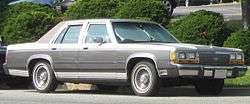 |
|
2-door sedan |
|
| Ford Crown Victoria
|
1992-2012 | 4-door sedan |
|
| Ford Crown Victoria Police Interceptor/P71
|
1993-2011 (see notes) | 4-door sedan |
|
| Ford LTD Country Squire Mercury Colony Park
|
1979-1991 | 5-door station wagon |
|
| Mercury Marquis
|
1979-1982 | 2-door sedan 4-door sedan 5-door station wagon |
|
| Mercury Grand Marquis
|
1983-2011 | 2-door sedan 4-door sedan 5-door station wagon |
|
| Mercury Marauder
|
2003-2004 | 4-door sedan |
|
| Lincoln Continental Mark VI
|
1980-1983 | 2-door sedan 4-door sedan |
|
| Lincoln Continental Lincoln Town Car
|
|
2-door sedan (see notes) 4-door sedan |
|
Variants
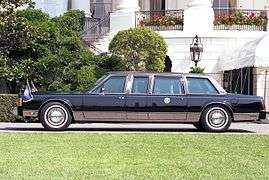

- The 1993 Aston Martin Lagonda Vignale concept car was developed, underpinned with a modified Lincoln Town Car chassis and powertrain.
- Approximately 100 Hongqi CA 7465 limousines were produced in the mid-1990s; they were license-built versions of the Lincoln Town Car built as a stretch limousine; Hongqi rebodied the front bodywork with new sheetmetal similar to the 1970s CA770.
- The 1998-2005 Hongqi CA7460(红旗CA7460) and Hongqi Qijian(红旗旗舰) (flagship) were license-built versions of the Lincoln Town Car built as luxury sedans primarily for government and military officials. After production in the U.S. by Ford, the cars were shipped to China for final bodywork.
- The 2002 Mercury Marauder concept car served as a preview of the 2003 production sedan. Based on a 1999 Ford Crown Victoria, the Mercury Marauder was converted into a 2-door and changed to a (topless) convertible. It also was given a supercharged version of the 4.6L Modular V8; in production, the engine was changed to a naturally-aspirated DOHC V8.
- The Presidential State Car built for President George H. W. Bush is based upon a 1989 Lincoln Town Car. Along with armor plating, bulletproof glass, and undisclosed security modifications, the standard powertrain was replaced with a 7.5L Lima V8 and 4-speed E4OD automatic transmission from a F-250 ¾-ton pickup truck.
Discontinuation
As a followup to the 2003 update of the Panther platform, during most of the 2000s, design efforts were under consideration by Ford Motor Company to develop an all-new rear-wheel drive sedan platform. Intended as the first truly new full-size chassis in over two decades, the platform was intended to consolidate the Panther platform and the slightly smaller EA169 platform used by Ford Australia (for the Ford Falcon and Ford Territory, with the Ford Fairlane/LTD nearly matching the Crown Victoria/Grand Marquis in wheelbase).
Serving as potential previews of potential rear-wheel drive Ford and Lincoln-Mercury vehicles, Ford debuted the Ford 427, Lincoln MKR, and Ford Interceptor concept vehicles during the mid-2000s. While none of the vehicles would reach production in their entirety, design elements be used in various forms of production vehicles. In January 2009, Ford announced that design efforts towards its global rear-wheel drive platform were canceled.[5]
Since the 2007 model year, the full-size retail presence of the Ford brand shifted from the Ford Crown Victoria to the Ford Taurus, previously marketed as the Ford Five Hundred. In 2009, Ford announced that 2011 was to be the final year for the Crown Victoria Police Interceptor with a new police-specific vehicle to begin production.[6]
2011 would slowly mark the phaseout of both Panther-platform production and of vehicle production at St. Thomas Assembly. On January 4, the final Grand Marquis rolled off the assembly line, marking the end of Mercury production after its 2010 closure. During August, the final Lincoln Town Car rolled off the assembly line.[7] After a short run of 2012 GCC-export models were produced (as it was no longer legal for sale in North America), the final Ford Crown Victoria rolled off the assembly line on September 15, 2011.[8]
Before the Mercury Grand Marquis and Lincoln Town Car would end production, Ford would introduce functional replacements for the Crown Victoria/Grand Marquis (in the sixth-generation Ford Taurus and Ford Police Interceptor Sedan) and Lincoln Town Car (in the Lincoln MKS). In large contrast to their predecessors, sales of the Taurus/MKS were less dependent on fleet customers, intended for retail purchases. An exception was the Ford Police Interceptor Sedan; based on the Ford Taurus SHO, the model was developed to continue to serve law enforcement customers. To serve livery customers, Lincoln continued to develop variants of the Lincoln Navigator SUV, along with livery and limousine variants of the Lincoln MKT CUV; specific versions would adopt the Lincoln MKT Town Car name.[7]
References
- ↑ Robert Cumberford (15 July 2011), "How I'd Save the Lincoln Town Car", Automobile Magazine
- ↑ Jim Mateja (4 October 1987). "Changes for '88 show that Ford is listening". Chicago Tribune. p. E1.
- ↑ LLC, AEC Global. "Panther Crossmember - trever skilnick". www.treverskilnick.com. Archived from the original on 2016-04-22. Retrieved 2016-03-15.
- ↑ "Box Panther Production Numbers". Retrieved 18 June 2014.
- ↑ http://www.autoweek.com/apps/pbcs.dll/article?AID=/20090111/FREE/901119958
- ↑ "Archived copy". Archived from the original on 2011-05-19. Retrieved 2011-01-04.
- 1 2 "Ford Hopes Limo Companies Will Replace Town Car With Lincoln MKT". Pittsbur igh Post-Gazette. 7 October 2010.
- ↑ "Hundreds out of work as Ford's St. Thomas plant closes today". The Star. Toronto. 15 September 2011. Archived from the original on 25 October 2012.
